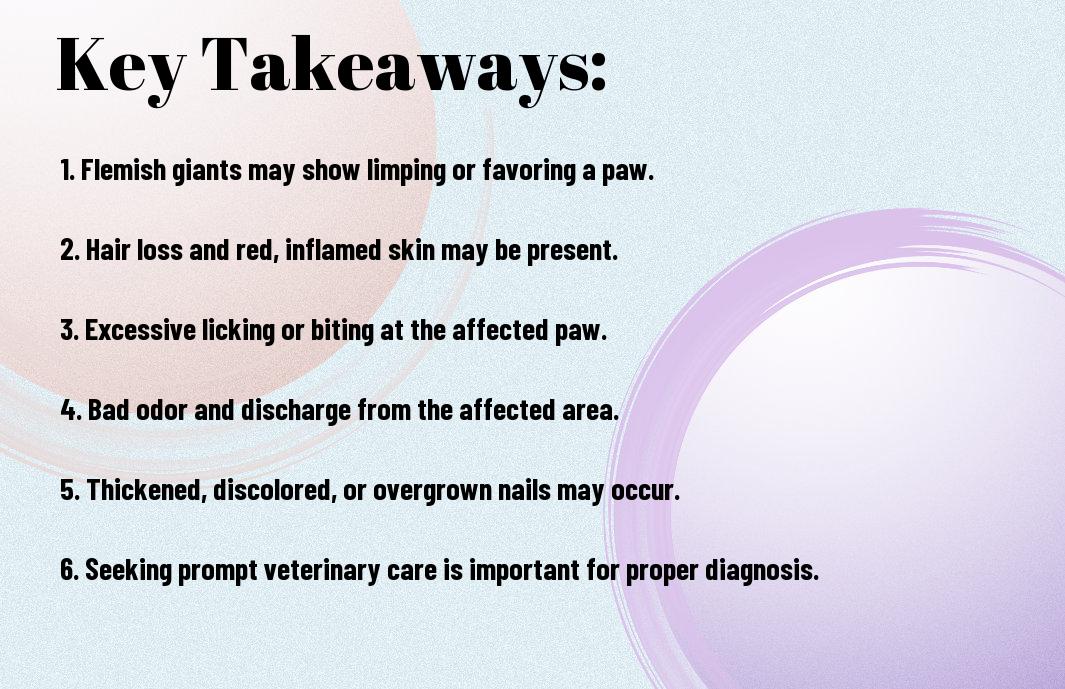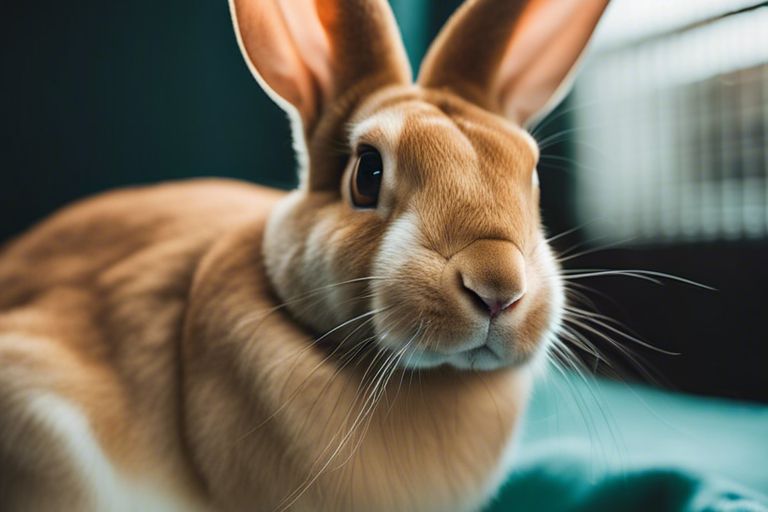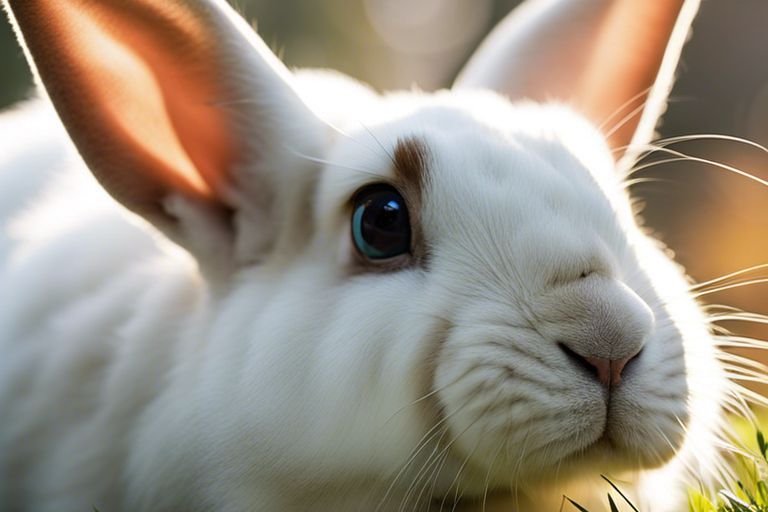Have you noticed any unusual behavior in your Flemish Giant rabbit lately? It could be a sign of a paw fungal infection. As a responsible pet owner, it is crucial to be aware of the symptoms so you can provide the necessary treatment and care for your beloved pet. Paw fungal infections can be uncomfortable and potentially dangerous for your rabbit if left untreated, so understanding the signs and seeking veterinary assistance is crucial.
Key Takeaways:
- Changes in Paw Appearance: Look for any redness, swelling, or discharge between the toes or on the paw pads.
- Aggressive Itching: If your Flemish Giant is constantly licking, biting, or scratching at their paws, it could be a sign of a fungal infection.
- Unpleasant Odor: A strong, foul odor coming from your rabbit’s paws may be indicative of a fungal infection.

Recognizing Paw Fungal Infections in Flemish Giants
For a Flemish Giant rabbit owner, it is essential to be able to recognize the symptoms of paw fungal infections in your pet. This will allow you to seek timely veterinary care and prevent the condition from worsening.
Symptoms Overview
When it comes to recognizing paw fungal infections in your Flemish Giant, there are several symptoms to be aware of. One of the most common signs is the presence of redness and swelling on the paws. You may also notice your rabbit licking or chewing on their paws more frequently than usual. In severe cases, you may even observe the formation of thick, crusted skin on the affected areas. It is important to be vigilant and keep an eye out for these symptoms, as early detection is crucial for successful treatment.
Early Detection and the Importance of Timely Response
Early detection of paw fungal infections in Flemish Giants is crucial for preventing the condition from worsening. If left untreated, the infection can spread and cause more severe symptoms, leading to discomfort and pain for your pet. Additionally, untreated paw fungal infections can lead to secondary bacterial infections, which can be even more challenging to treat. Therefore, it is important to seek prompt veterinary care at the first sign of symptoms. Timely response is key to ensuring the well-being of your beloved Flemish Giant.

Factors Contributing to Fungal Infections
Some key factors can contribute to fungal infections in Flemish Giants. These factors include:
- Prolonged exposure to moist environments
- Weakened immune system
- Poor hygiene
- Close contact with other infected animals
- Underlying health conditions
This can make your Flemish Giant more susceptible to fungal infections, so it’s important to be aware of these contributing factors and take necessary precautions to prevent them.
Environmental Causes and Hygiene
Environmental causes and poor hygiene can greatly contribute to the development of fungal infections in your Flemish Giant. This can include inadequate cleaning of the living environment, such as Dirty cage bedding and soiled litter boxes. Additionally, high levels of humidity and moisture in the air can create an environment where fungi thrive. Regular cleaning of your Flemish Giant’s living space is crucial to prevent the buildup of fungal spores and reduce the risk of infections.
Implications of Flemish Giant’s Size and Strength
The sheer size and strength of a Flemish Giant can also play a role in their susceptibility to fungal infections. Their large bodies can make it more difficult to properly clean and inspect every part of their fur and skin, creating more opportunities for fungi to take hold. Additionally, their powerful immune system may mask the early symptoms of a fungal infection, leading to delayed treatment. Regular grooming and close monitoring of your Flemish Giant’s health is essential to catch any signs of infection early.
Treatment and Fungal Infection Management
However, if your Flemish Giant rabbit is diagnosed with a paw fungal infection, it is crucial to start treatment as soon as possible to prevent the condition from worsening. The primary treatment for fungal infections in rabbits is antifungal medication, which can be prescribed by a veterinarian after a thorough examination of your rabbit’s symptoms. The medication may come in the form of oral tablets or topical ointments, depending on the severity of the infection. In some cases, your veterinarian may also recommend changes to your rabbit’s living environment or diet to support their recovery.
To learn more about Pasteurella and its health effects in rabbits, visit Pasteurella: Its Health Effects in Rabbits.
Veterinary Check-ups and Diagnosis
When you notice any symptoms of paw fungal infections in your Flemish Giant, it is essential to schedule a veterinary check-up immediately. Your veterinarian will perform a thorough examination to diagnose the infection and recommend an appropriate treatment plan. They may also conduct additional tests, such as skin scrapings or fungal cultures, to confirm the diagnosis and determine the specific type of fungus causing the infection.
Remedies and Paw Care
Once your rabbit is undergoing treatment for a paw fungal infection, it is essential to follow your veterinarian’s recommendations for paw care and remedies. This may include keeping the affected area clean and dry, applying prescribed antifungal ointments, and providing a comfortable environment for your rabbit to rest and heal. Additionally, your veterinarian may suggest specific remedies or supplements to support your rabbit’s immune system and overall well-being during the recovery process.
The Role of Grooming and Hygiene in Prevention
Regular grooming and maintaining proper hygiene for your Flemish Giant can play a key role in preventing paw fungal infections. By keeping your rabbit’s fur clean and free from moisture or dirt, you can reduce the likelihood of fungal growth and infections. Additionally, providing a clean living environment with proper ventilation and ensuring your rabbit has access to a balanced diet can support their overall health and reduce the risk of fungal infections.
Remember, early detection and proactive treatment are essential in managing paw fungal infections in Flemish Giants. By staying vigilant and taking proactive steps to care for your rabbit, you can help them stay healthy and happy.
Beyond Treatment: Flemish Giant Health and Well-being
After addressing the fungal infection in your Flemish Giant’s paws, it is important to consider their overall health and well-being. Taking care of your bunny goes far beyond simply treating the symptoms. It is essential to maintain a healthy lifestyle for your pet to prevent future health issues and ensure they lead a happy, comfortable life.
Nutrition and Its Impact on Skin and Paw Health
Proper nutrition is crucial for the overall health of your Flemish Giant, including their skin and paws. A well-balanced diet, consisting of high-quality hay, fresh vegetables, and a controlled amount of pellets, is important for maintaining healthy skin and ensuring optimal paw health. Make sure to avoid overfeeding, as obesity can lead to stress on their paws and skin issues. Additionally, provide your bunny with access to clean, fresh water at all times to keep them properly hydrated.
The Importance of Regular Exercise and Safe Housing Conditions
Regular exercise is essential for your Flemish Giant’s overall well-being, including their paw health. Encourage your bunny to exercise by providing ample space to roam and play. A lack of exercise can lead to weight gain and put additional strain on their paws. Furthermore, ensure that your rabbit’s housing conditions are safe and free from hazards that could cause injury to their paws. Provide appropriate bedding and clean living areas to prevent skin and paw infections caused by unsanitary conditions.
To wrap up
It is important to be aware of the symptoms of paw fungal infections in Flemish Giants, as they can be quite common in larger rabbit breeds. If you notice any signs such as redness, swelling, or discharge between your rabbit’s toes, it is essential to seek veterinary care promptly. By being proactive and recognizing these symptoms early on, you can ensure the health and well-being of your Flemish Giant and prevent the spread of the infection.
FAQ
Q: What are the common symptoms of paw fungal infections in Flemish Giants?
A: The common symptoms of paw fungal infections in Flemish Giants include redness, swelling, and irritation of the paw pads. You may also notice excessive licking or chewing of the paws, along with a foul odor emanating from the affected area.
Q: How can I distinguish between a fungal infection and other paw issues in my Flemish Giant?
A: Fungal infections in Flemish Giants often present with distinct symptoms such as thickening or cracking of the paw pads, as well as the development of lesions or sores. Additionally, if the infection is left untreated, it may spread to other areas of the body, causing further discomfort for your pet.
Q: What should I do if I suspect my Flemish Giant has a paw fungal infection?
A: If you suspect your Flemish Giant has a paw fungal infection, it is important to consult a veterinarian for a proper diagnosis and treatment plan. Avoid attempting to treat the infection at home, as improper care may exacerbate the issue. Your veterinarian may prescribe antifungal medications or recommend topical treatments to alleviate the symptoms and promote healing.
